

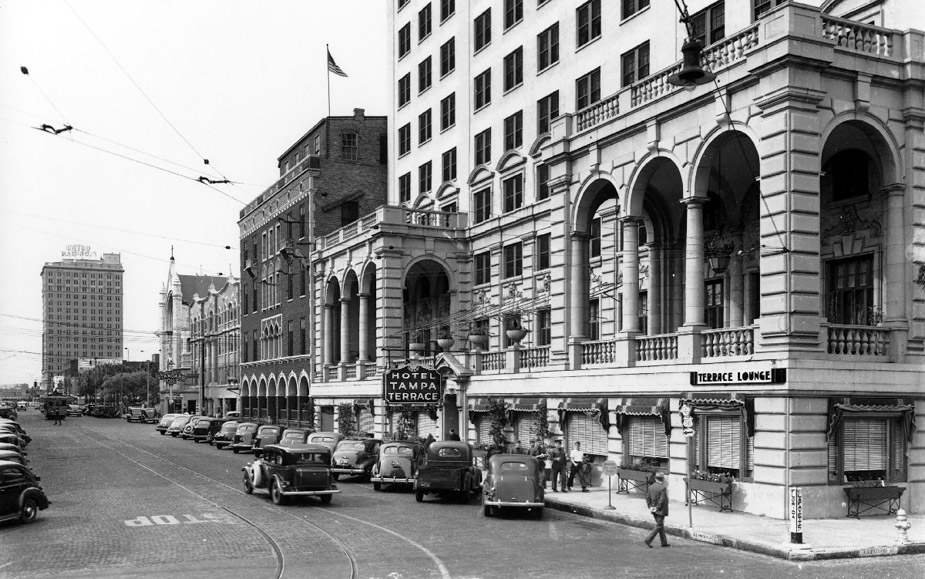
The Tampa Terrace Hotel at 411 N. Florida Ave. at
Lafayette St., circa early 1940s
L to R: Hotel Floridan, Sacred Heart church, Tampa
College/Jesuit High School, Elks
Lodge, Hotel Tampa Terrace
Click here to see a close
up of the corner of the Elks Lodge building and Elk replica.
Robertson
& Fresh photo from the USF Digital Collection.
|
During the War—and Afterwards From the time the Japanese bombed Pearl Harbor on December 7, 1941, until Japan surrendered nearly four years later, Tampa people subordinated everything to the main task of winning the war, just as people did everywhere throughout the nation. Thousands of Hillsborough County men were fighting in all parts of the world, from the fog-shrouded rocks of the Aleutians to the steaming jungles of New Guinea and the bloody battlefields of North Africa, Italy, France and Germany. Rarely did a week pass without word being received of several having made the supreme sacrifice. It was little wonder, therefore, that Tampans did not complain about the seemingly endless red tape and inconveniences of all forms of rationing, about restrictions against traveling, or about running short occasionally in a few items of food. Like soldiers on the homefront, the buckled down to the task of putting over war bond and Red Cross drives, serving as air wardens or waterfront guards, and doing everything possible to hasten the war’s end. Throughout the entire war, and for many months thereafter, Tampa was crowded with servicemen. Not only with men who were stationed at MacDill and Drew fields, but with fighter pilots who were being trained at Pinellas County Air Base, air corps technicians from St. Petersburg, and servicemen from camps all over Florida who came to Tampa on furloughs or leaves to enjoy themselves. The hotels were always filled. Stores, restaurants and cafes did a record-smashing business. Everyone had money to spend—and they spent it. |
|
|
|
|
||
|
While the war was in progress, Tampa got a new mayor, Curtis Hixon succeeding Mayor Robert E. Lee Chancey in 1943. Chancey had served the city for twelve years, the stormiest in the city’s history. He had been elected in 1931, defeating T. N. Henderson in a 7901 to 6632 vote wild election in which charges of vote fraud abounded. To assure a “clean election,” police guarded the voting booths and arrested a hundred voters suspected of illegal practices. To add to the excitement, sheriff’s deputies arrested the police. For a time it looked as if Tampa would have a civil war. When Chancey took office, Tampa’s financial affairs were in a sorry state. The city’s interest payments on bonds obtained for necessary public improvements were taking most of the city’s depression-depleted revenues. The city could not meet its payrolls. Chancey slashed the police and fire departments budgets by $100,000 a year. Several fire stations were closed and other city departments were similarly cut. Remaining employees were given part of their pay in certificates. Before the depression ended, the city had to borrow $750,000 from RFC to obtain funds for city –sponsored WPA projects. To relieve the strain, the city’s merchants finally agreed to pay a special tax on gross business. Mayor Chancey was re-elected in 1935. After the election, charges were made that he and his political followers had been guilty of intimidating voters, stuffing the ballot boxes and doctoring the results. As the result of the alleged fraud, a movement to get voting machines, pioneered by W. R. Letcher, received wide popular support and the machines were finally purchased and installed. |
|
|
|
|
||
|
|
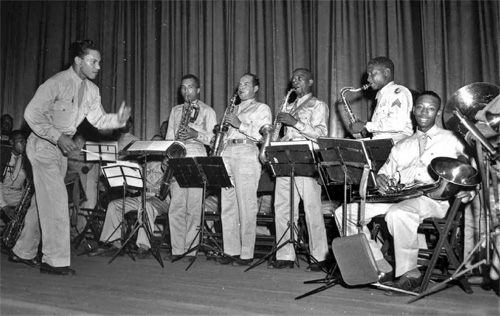 135th Army swing band, 1943 Robertson & Fresh photo from USF Digital Collections |
|
|
In his bid for a fourth term in 1943, Mayor Chancey was opposed by Hixon, a druggist who had come to Tampa from Alabama in 1910. Hixon had served two terms as city alderman, had twice been elected as a county commissioner, and was popular. He defeated Chancey by a large majority. The election marked the beginning of a reform wave which culminated in 1945 in a losing battle for the return of the city manager form of government, but which effected a charter revision providing for representatives elected at large instead of by wards. It also increased the powers and duties of the mayor. Hixon took office at the peak of the war, when the city was filled with servicemen, and he put the resources of the city into drives to curb vice and venereal diseases, which had taken an upturn during the war years. He also began building up city departments which had become run down during the long depression years. He was able to perform this much-needed task because the city had by that time started to become prosperous again and tax payments were increasing steadily. |
|
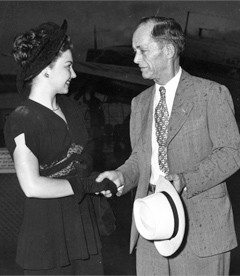 Mayor Curtis Hixon and Tampa actress Mary Hatcher, 1947. Robertson & Fresh photo from USF Digital Collection. |
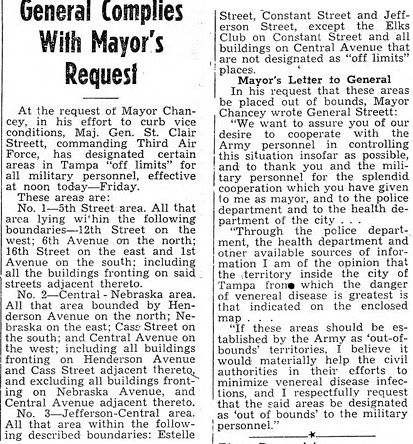
Mayor Chancey declares areas of Ybor "off
limits" to servicemen. |
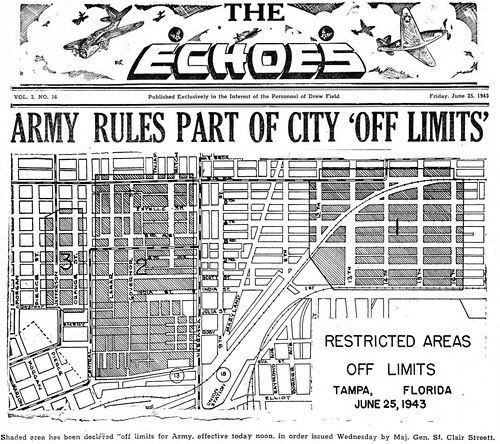 Restricted areas of Tampa/Ybor |
|
|
The U.S.S. Mauna Loa being launched from her berth in Port Tampa, 1943. Burgert Bros. photo from the Tampa Hillsborough County Public Library.
Boogie
Woogie Bugle Boy
July 7, 1944 - Sailors and civilians along with military band celebrate E-Day at TASCO construction yard. Burgert Bros. photos from the Tampa Hillsborough County Public Library. |
||
|
Because of the war, and also because of politics, the entire Tampa Bay area was benefitted in 1944 by the action of the federal government in taking over the Gandy Bridge and eliminating the toll. A free bridge had long been urged by civic leaders in both Tampa and St. Pete, but officials of the Gandy Bridge Company, then reaping a rich harvest, succeeded in blocking all attempts to get action. However, they made the mistake of failing to make arrangements for servicemen to obtain passes easily, and the government, spurred by Senator Claude Pepper, intervened. Just before the primary election of 1944, the bridge was commandeered by the government under provisions of the act which conferred war emergency powers upon the president. This action, it has been said, re-elected Pepper to the senate. Gandy Bridge became a free bridge at 1:30pm, April 27, 1944. up to that time, a toll of 35c had been charged for each car and 5c for each passenger. A jury fixed the price paid to Gandy Bridge Company at $2,382,642. See more photos and history about George Gandy and his bridge Ben T. Davis Causeway, the connecting link between Tampa and Clearwater, was taken over by the State Road Dept. six weeks before the federal government took over Gandy Bridge. The take over for the nine-mile causeway and 3,510 foot bridge was $1,085,000, of which the Federal Works Administration paid half, and the State Road Dept. the remainder. The causeway had been started in 1927 by Capt. Benjamin T. Davis but work on it had been halted first by the Florida crash and later by the national depression. Finally, in 1933, Davis secured an RFC loan and completed its construction. It was opened on Thursday, June 28, 1934, with ceremonies sponsored by Corita Davis, daughter of the builder. A gate of flowers was cut by a group of Tampa girls including Elizabeth Sharpe, Mary Fernandez, Becky Price, Mary Catherine Michler, Robie Webb, Mrs. Sallie G. Bannon and Kathleen Simpson. Speeches were made by Governor Doyle E. Carlton and Mayor Chancey. After the war ended, the causeway was greatly improved and beautified by the State Road Dept., palms and shrubs being planted along its entire length and many attractive picnic shelters for motorists were built. Commissioners in Hillsborough and Pinellas counties were so well pleased by the development that they changed the name of the causeway to the Courtney Campbell Parkway, honoring the man who was then the Tampa district member of the road department. Shortly thereafter, the department leased to the city of Tampa a tract of land at the east end of the causeway for use as a municipal bathing beach and picnic grounds. Plans for development of the beach at a cost of around $1 million were nearing completion at the end of 1949. In addition to the beach improvements, there were plans to build a casino, with dining room, lounge, roof garden, bar, balcony and convention room large enough t seat 1,000 persons; a fresh water swimming pool, two large bath houses, four cabanas, parking lots and landing slips for small boats. Work on the project was expected to start in 1950.
|
|
|
|
Capt. Ben T. Davis
|
||
|
|
||
|
|
|
The lunch
counter at J. J. Newberry, 815 Franklin St. at Polk St., 1941 |
Page1 | Page2 | Page3 | Page4 | Page5 | Page6 | Page7 | Page8 | Tampapix Home